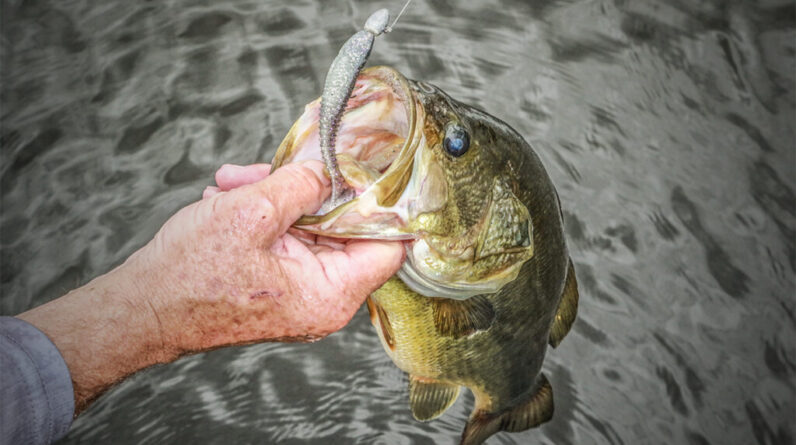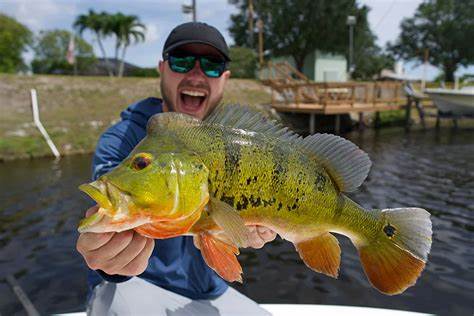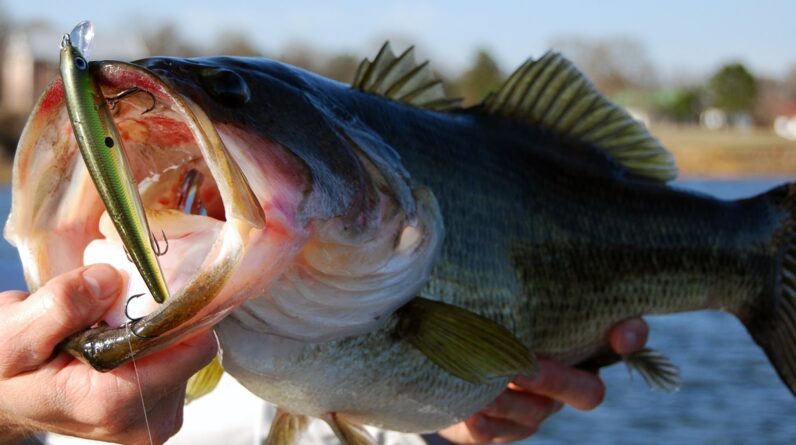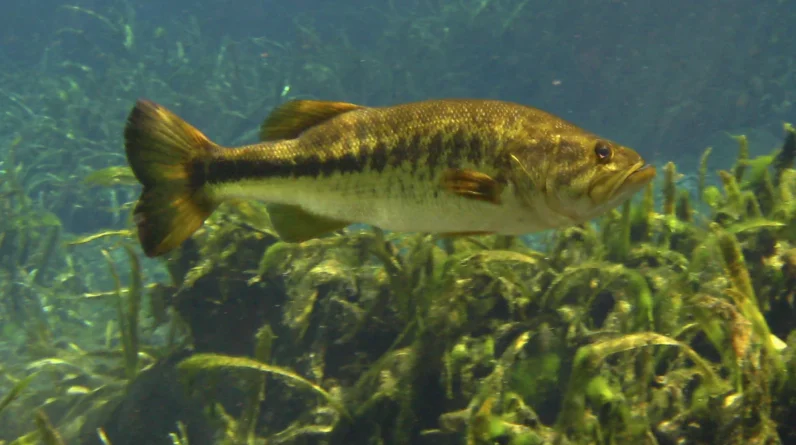Lures for Bass in Fall 2025: Fall is a magical, frantic time for bass fishing. As water temperatures drop and forage (especially shad and baitfish) school up, bass shift from spawn or summer patterns into an aggressive feeding mode. They gorge to bulk up for colder months — which makes fall one of the most productive seasons for catching big bass. But to get the most out of autumn, you need the right lures, the right colors, and the right approach.
This comprehensive guide, created by the team at Cheerfulfisherman.com for Fall 2025, is built to give anglers everything they need for a successful season. Inside, you’ll find expert insights into seasonal bass behavior, the lure categories that dominate autumn fishing, and detailed breakdowns of specific lure models (including brand, size, and color). We also cover rigging and tackle setups, retrieve techniques, and advanced strategies tailored for clear, stained, and very cold water conditions. To make your preparation even easier, the guide includes a fall-ready tackle checklist, an FAQ section, and a concise buying guide highlighting which lures deserve priority on your next trip or tackle order. Whether you’re a seasoned bass angler or just getting started, this resource ensures you’ll head to the water fully prepared.

Why fall is so good for bass (behavior & water conditions)
Autumn is a feeding window. As days shorten and surface temps fall (commonly from the high 60s down into the 50s–40s °F depending on region), bass switch from spawning/summer patterns to a forage-driven mindset. Baitfish concentrate on schooling edges (points, mid-lake humps, creek mouths, and steep drops) and bass follow them. That concentrated forage means fewer, more predictable ambush points — and opportunities for anglers to exploit with the right lures.
Experts who tested 2025 lures and fished extensively this year emphasize that many of the new and proven baits — topwater frogs, micro cranks, blade baits, and swimbaits — are especially effective for fall because they mimic the shad and baitfish bass chase in that season.
Key fall behaviors to remember:
- Bass move from scattered summer locations to defined ambush points (drop-offs, points, flats adjacent to deep water).
- They feed aggressively in short windows (morning and late afternoon are often best but schooling can happen midday).
- Shad and schooling forage dictate where bass are; follow the baitfish.
- Water clarity matters a lot: lure selection and color choice should be matched to clarity and prevailing forage.
How to read water and locate fall bass
Before grabbing lures, spend the first 10–30 minutes diagnosing the water:
- Look for baitfish activity. Surface boils, birds diving (where applicable), and ripples or swirling fish marks are hints.
- Use electronics. Modern sonar shows schools. In fall, schools often stack along breaklines and edges of submerged structure. Throw a few long casts to the edge of the school (or right into the school if using a topwater) and see what happens.
- Check depth transitions. Bass often stage on 8–20 ft breaks in fall (deeper in some big reservoirs). Points that run to deeper water and humps that have shell or rock flats are prime.
- Water temperature. If the lake moved from the mid-60s to low-60s or below over a few nights, bass often go into a feeding surge; adjust baits accordingly.
Top lure categories for fall — quick summary
The fall angler’s short list:
- Crankbaits (medium & deep) — run breaklines and edges, trigger reaction strikes.
- Lipless crankbaits — search baits that cover water quickly and mimic fleeing baitfish.
- Spinnerbaits — reliable in stained water and around timber/rock.
- Jigs (football & flipping jigs) — perfect for heavy structure and slow bites.
- Soft plastics (swimbaits, worms, creature baits, Ned rigs) — finesse and lifelike action when bass are keyed in on specific forage.
- Blade baits & chatterbaits (bladed jigs) — great at mid-depth and for cold-water reaction bites.
- Topwater (early fall and when baitfish are surface-feeding) — walking baits, poppers and prop baits for explosive strikes.
- Large glidebaits & big swimbaits — used where big bass are staging on big schools of bait and when you want to target giants.
Deep dive: Best lures by category (with model suggestions for Fall 2025)
Below I list the most effective lure categories for fall — and for each give specific models (brand, size, color), why they work, tackle to pair, how to fish them, and when to choose them. I cite 2025 testing where relevant.
Crankbaits (shallow, medium, deep) — fall winners for structure and points
Why crankbaits: Crankbaits run a consistent depth and cover water quickly. In fall, bass are often on edges and ledges; a medium-to-deep crank that runs the exact breakline often produces big reaction strikes.
Top recommended models for Fall 2025:
- SPRO Little John Micro 45 (micro shallow/med) — compact, tight wobble; good for shallow flats and mid-depth schooling edge. Recommended in shad/pearl or chartreuse shad screens.
- Shimano Gravitator 220 SS Glidebait (for larger glide-style dives/long casts) — when you need a big profile to provoke big bass near schooling shad.
- Storm Original Wiggle Wart (classic deep/medium) — often referenced as reliable for consistent diving and provoking reaction bites.
Sizes & colors:
- Shallow crankbaits: 1.5–2.5 inch bodies; shad, pearl, white, baby bass patterns.
- Medium & deep cranks: 2.5–4 inch bodies; shad, chrome, blueback herring, crawfish (where bass feed on craws). In fall prioritize shad and natural baitfish patterns because schooling shad is often dominant.
How to fish:
- Cast parallel to breaklines or run points, retrieve with a steady cadence and occasionally pause to let the bait rise slightly (especially with shallow/medium cranks).
- Let deep cranks bump structure—bass often hit on contact.
- Use braided line with a fluorocarbon leader on deeper cranks for sensitivity and hooksets.
Tackle: Medium-heavy casting outfit for deep crankbaits, medium for shallow/medium; 10–20 lb braid with 10–20 lb fluorocarbon leader depending on cover.
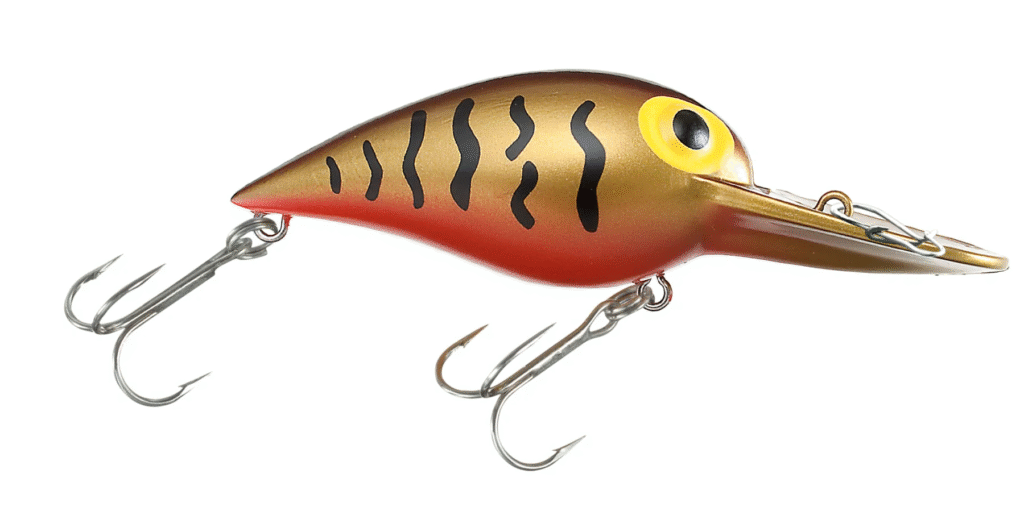
Lipless crankbaits — search and reaction in open water & bait schools
Why lipless: Lipless cranks are workhorse search baits in fall — they cover water fast, produce loud vibrations, and mimic fleeing baitfish. They’re particularly effective over flats, shoals, and through schools of shad.
Top models for Fall 2025:
- Bomber Fat Free (classic) and modern replacements; and many modern copies like Rapala PXR Jowler 127 are popular choices among 2025 picks.
Sizes & colors: ½ oz to 1.5 oz; shad, chrome, blue back, white, black/blue for low light.
How to fish:
- Straight retrieve at medium-high speed, pop the rod for short burns, experiment with lifting/stopping to imitate wounded fish.
- Use when finding scattered or schooling bass in 6–20 ft ranges.
Tackle: Medium-heavy rod, braid 30–50 lb if flipping heavy cover or 12–20 lb braid for open water with fluorocarbon leader.
Spinnerbaits & inline spinners — versatility in stained water
Why spinnerbaits: Spinnerbaits shine in stained or dingy water where flash and profile read well at distance. They’re versatile for covering water and drawing reaction strikes around shallow grasslines, submerged timber, and points.
Top models & picks 2025:
- Traditional Colorado or Indiana-blade spinnerbaits from major brands; SPRO Cover Jumper was featured in 2025 lists for shallow-cover action.
Colors: White/chartreuse, shad, smoke/black for low light, brown/green pumpkin for stained water in murk.
How to fish:
- Slow-roll along drop-offs and points; burn through shallow flats when baitfish are fleeing; yo-yo retrieves can trigger reaction strikes.
Tackle: Medium rod, 12–20 lb fluorocarbon or braid depending on vegetation; pair with a wire leader if targeting toothy fish isn’t an issue.

Jigs & football jigs — heavy structure and slow days
Why jigs: When bass are tight to structure (timber, rock, docks) and bites are short, a jig gives you precise presentations and heavy hooksets. Football jigs are the go-to for covering rocky bottoms and deeper structure; flipping jigs and palomino-style jigs are unmatched around heavy cover.
Top models for Fall 2025:
- Buckeye Lures G-Man Ballin’ Out Jig (a tested pick). Use 3/8–1 oz depending on depth and current.
Colors: Black/blue, brown/green pumpkin, black/green, jigs with natural trailers like craw trailers.
How to fish:
- Drag or hop across bottoms on points and humps; slow fetch and hold to invite reluctant bass.
- When flipping; use stout line (30–50 lb braid) and heavy jigheads (3/4–1.5 oz) depending on cover.
Tackle: Heavy-action flipping rods; braided line 40–65 lb when punching mats or flipping dense timber.
Soft plastics: worms, creature baits, swimbaits, drop-shot & wacky rigs
Soft plastics are fall staples — they provide subtle, life-like action and can be fished in finesse or heavy styles. Below are the specific soft-plastic strategies that consistently produce in autumn.
1) Soft swimbaits
Why: Imitates schooling baitfish at many depths; excellent when bass are keyed on shad schools.
Top picks 2025: Medium swimbaits from established makers (e.g., 3.5–5 inch profiles, paddle tail or segmented). Field testing in 2025 highlighted swimbaits and glidebaits as effective when schools are large.
How to fish: Texas rigged or on jigheads; slow steady retrieve or a stop-and-go. For big swimbaits/glidebaits, use baitcasting reels and heavy rods.
2) Soft creature baits & flappies (Texas-rigged)
Why: Great around timber, rock, and docks; the compact profile incites reaction strikes.
Models: Gambler, Berkley PowerBait MaxScent creatures; size 3–5 inches.
How to fish: Texas rigged with 3/0–5/0 offset hooks; fish on points or along edges with slow crawls or hops.
3) Worms (wacky & shakey rigs)
Why: The wacky rig (Senko-style) and shakey-head presentations are perfect for isolated, finicky bass, especially on cooler days or in clear water. Many tournament anglers keep a drop-shot/wacky tied on for quick changes. The Neko and wacky rigs were still top producers in 2025 tournament play.
How to fish:
- Wacky rig: cast to structure, let fall, twitch occasionally.
- Shakey head: subtle hops and small shakes; works well on deeper flats.
Sizes & colors: 3–6 inch Senkos; green pumpkin, watermelon seed, smoke, and natural shad patterns.
4) Ned rig
Why: The Ned rig is perfect for pressured fish and clear water. Small profile, vertical fall — excellent in late fall when fish are picky.
How to fish: Small mushroom-head jig (1/16–1/8 oz) with small stick bait; dead-still or subtle lifts.

Topwater — explosive early/mid fall surface bites
Why topwater: When baitfish are schooling near the surface or bass push schools into edges, topwater baits create unforgettable explosive strikes. Early fall (and calm low-light windows) are prime times.
Top 2025 topwater picks: Gambler Walking Frog (Field & Stream’s best overall for 2025), prop baits, poppers, and stickbaits remain reliable presence.
How to fish: Walk-the-dog retrieves with pauses; pausing a popper at the end of the stroke invites commitment. Use braided line for immediate hookup.
Colors: Natural frog patterns for mats/weedlines, shad/pearl for open flats.
Blade baits & chatterbaits — cold-water reaction baits
Why: Blades and bladed jigs cut through the water column with strong vibration and are ideal for colder periods when bass are less aggressive but will react to vibration.
How to fish: Vertical jigging on schooling fish or cast-and-burn approaches along points and drop-offs. Blade baits work well in 8–25 ft depths.
Glidebaits & large swimbaits — for big bites on big fish
Why: When big bass stack on large schools of baitfish in fall, a large glidebait or big swimbait can trigger strikes from trophy bass that otherwise ignore smaller offerings. 2025 testing continues to show that glidebaits and bigger profiles can change the game in the right conditions.
How to fish: Long casts, slow rolling/gliding along schools and staging areas. Use heavy rods and braided mainline with heavy fluorocarbon leader for better hook penetration.
Rigging, line, rod, and reel choices for fall 2025
Choosing the right outfit is as important as choosing the right lure. Here’s quick guidance by lure type:
- Crankbaits (deep): Rod: medium-heavy, fast action; Line: 12–20 lb fluorocarbon or 20–30 lb braid + 12–20 lb leader. Reel: baitcasting with decent retrieve ratio.
- Lipless crankbaits & spinnerbaits: Rod: medium-heavy; Line: 12–20 lb braid or fluorocarbon; reel: baitcasting or two-handed spinning for bigger models.
- Topwater: Rod: medium-heavy for power hooksets; Line: braided 30–50 lb for instant hookup; reel: baitcasting.
- Jigging & flipping: Rod: heavy-action flipping or jig rod; line: 40–65 lb braid for flipping/punching; heavy rods required.
- Finesse soft plastics: Rod: medium-light to medium for drop-shot and wacky; 6–10 lb fluorocarbon or 6–12 lb braid/fluoro for leader.
- Blade and chatterbaits: Rod: medium-heavy; line: 12–20 lb braid or fluorocarbon depending on cover.
General tip: match the line to the situation — braid gives sensitivity and casting distance; fluorocarbon gives stealth and abrasion resistance. In fall, when bass are aggressive, braid with a fluorocarbon leader is a common universal setup for many presentations.

Retrieve techniques and advanced tips (tempo, pauses, speed changes)
What sets good anglers apart in fall is not only the lure but how they fish it.
- Crankbaits: retrieve cadence matters. Try steady retrieves interspersed with short pauses. Let deep cranks bump cover.
- Lipless cranks: burn, then pause; or steady retrieve with quick pops. Vary speed to find what triggers reaction.
- Spinnerbaits: slow roll, but occasionally speed up for reaction; in front of shallow rock or timber, a slow roll with occasional pauses draws fish.
- Jigs: hop-and-deadstick; subtle craw rhythm. On cold days, slower is better.
- Soft plastics (wacky & drop-shot): allow for long falls; twitch once or twice on the fall; hold longer than you think. Bass often hit on the fall.
- Topwater: walk-the-dog, twitch, and immediate pause; sometimes a single twitch can trigger explosive surface strikes.
Pro tip: when you find fish, don’t be afraid to slow down and finesse the presentation — many fall bites happen on subtle, patient retrieves.
Water clarity, forage-driven color choices, and seasonal color charts
Color selection is crucial in autumn since forage (shad vs crawfish) drastically affects what a bass will eat.
Rule of thumb:
- Clear water: natural shad profiles, pearl, smoke, green pumpkin with translucent traits. Fluorocarbon line recommended.
- Stained water: bright shad, white/chartreuse, bluegill patterns, and bold color contrasts. Spinnerbaits in white/chartreuse shine here.
- Dark/dirty water: black/blue and high-contrast colors, big profiles, and loud vibrations (bladed baits or spinnerbaits).
- Low light / early morning / overcast: darker silhouettes (black/blue) or high-contrast chrome finishes.
Always match the predominant forage. If you see shad, choose shad patterns (silver/blueback/chrome). If bass are feeding on crawfish in shallower systems, consider darker crawfish colors (brown/black/gold). Lurenet and field guides confirm that shad-focused patterns dominate in many fall fisheries and that anglers should leverage shad colors as the first choice.
Trick tactics: transitions, points, main lake flats, and schooling baitfish
Transitions & points: Points that transition shallow to deep are fall gold. Cast parallel and cover water with lipless cranks or spinnerbaits. When you find bait stacked on the edge, set up and pitch a swimbait or a glidebait to the school.
Main-lake flats near deep water: often hold bass in early morning; fish here with topwater or shallow crankbaits on the first light hour.
Schooling baitfish: when you locate a school, try:
- Blade baits vertical jigged under the school.
- Topwater if they’re busting on the surface.
- Large swimbait or glidebait to target bigger individuals.
- Lipless crank burned through the school to force reaction strikes.
Edge-to-depth technique: run a spinnerbait along the transition and then make an accurate pitch with a jig or Texas-rigged creature to the exact strike zone.
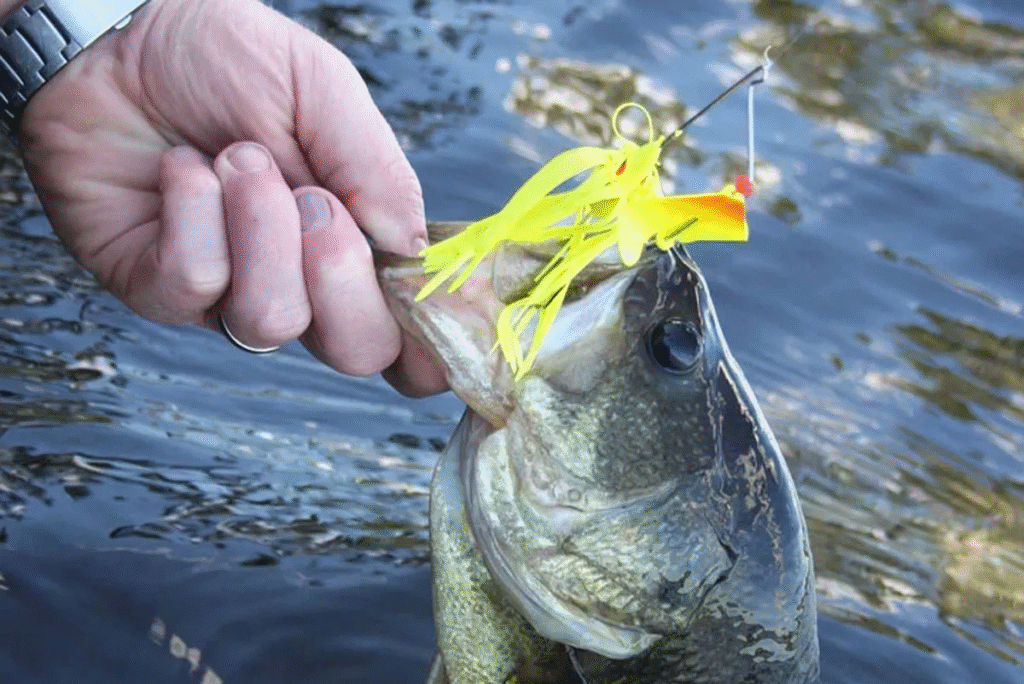
Tackle box checklist: what to buy & stock up on this fall
Here’s a prioritized shopping list for Fall 2025 — balanced between essentials and higher-end picks.
High-priority (must-have):
- 3–4 medium-to-deep crankbaits (shad patterns) — e.g., SPRO Little John Micro 45, Wiggle Wart.
- 2 lipless cranks (½–1 oz) in shad/white and black/blue.
- 2 spinnerbaits in white/chartreuse and black/blue.
- 2 football jigs (3/8–3/4 oz) with craw trailers.
- Pack of 3–6” swimbaits and a few 3.5–4” paddle tails.
- 12–20 Senkos (wacky) in various shad/crawfish colors.
- 2 blade baits or chatterbaits.
- 2 topwater baits (walking bait + popper).
- Assortment of weights, hooks (offset worm 3/0–5/0), jig heads (1/16–1/2 oz), split rings & trebles replacement.
Optional/premium:
- Glidebait (Shimano Gravitator 220 SS or similar) for large-water situations.
- Big swimbait (5–7 inch profiles) if targeting trophy fish.
- Quality braided line spools (65–150 yd) and fluorocarbon leader spools (10–40 lb).
Budget vs. premium lures — where to spend and where to save
Where to spend:
- Crankbaits and glidebaits: reliability and action matter — buy trusted brands for consistent action and durable hooks.
- Topwater & swimbaits: premium finish and realistic profiles often convert to more strikes.
- Jigs: invest in durable jigs with quality skirts and strong hook points.
Where to save:
- Soft plastics: many generic soft plastics fish well; you can save money on bulk packs for wacky rigs and Ned baits.
- Accessory tackle (split rings, weights, basic hooks): generic brands often work fine; keep spares.
Frequently asked questions (FAQs)
Q: What’s the single best lure for fall 2025 if I can only pick one?
A: If you must pick only one, a versatile lipless crankbait (in a shad/chrome pattern, ½–1 oz) or a medium-deep crank in shad colors is the go-to. They cover water quickly and match schooling baitfish behavior. Several 2025 expert lists and tests show lipless and medium cranks as consistent fall producers.
Q: Do topwater lures still work in fall?
A: Absolutely — when bass are feeding on the surface (morning/late afternoon or during choppy conditions), topwater produces explosive strikes. Some 2025 picks included topwater frogs and walking baits as top performers.
Q: Should I fish slower or faster in fall?
A: Start fast for discovery (lipless, spinnerbait), then slow down to finesse retrieves (jigs, soft plastics) when you locate the active fish or if fish are pressured or colder.
Q: What line should I use around vegetation and mats in fall?
A: Heavy braid (40–65 lb) for punching mats and dense vegetation; braided mainline with a fluorocarbon leader for snag-resistance and stealth in open water.
Final wrap + recommended shopping list for immediate action
Fall 2025 is stacked with excellent lure choices — from trusted classics to innovative new baits released at ICAST 2024 and tested in 2025. The winning strategy this fall: match the forage, locate the schools, cover water efficiently, and be ready to switch between reaction baits (lipless, spinnerbait, crank) and finesse presentations (jigs, soft plastics).
Immediate 3-lure starter pack for fall success (buy these first):
- Lipless crankbait (½–1 oz, shad/chrome) — covers water fast.
- Medium-deep crank (shad pattern) — for breaklines and points.
- Football jig or flipping jig (3/8–¾ oz, craw trailer) — for structure and big bass.
For further reading and top picks compiled from 2025 tests and expert reviews, consider Field & Stream’s mid-2025 best-lures roundup and Bassmaster’s tournament lure lists to see what pros used at the Classic. These sources highlight the baits that consistently produced in real-world testing and events this year.
Appendix A — Quick color guide (one-line cheat sheet)
- Clear water: natural shad, pearl, smoke.
- Stained: white/chartreuse, bluegill, fire-tiger variants.
- Dark water/low light: black/blue, chrome finishes.
- Vegetation: green pumpkin, brown pumpkin, black/green.
Appendix B — Quick rigging cheat sheet
- Texas rig (weedless, creature baits): 3/0–5/0 offset hook, bullet weight 1/8–¾ oz.
- Ned rig: mushroom head 1/16–1/8 oz, small stick bait.
- Drop-shot: 6–10 lb fluorocarbon, 1/8–¼ oz weight, 6–8 inch leader.
- Jig: 3/8–1 oz depending on depth; trailer: craw or pork.






